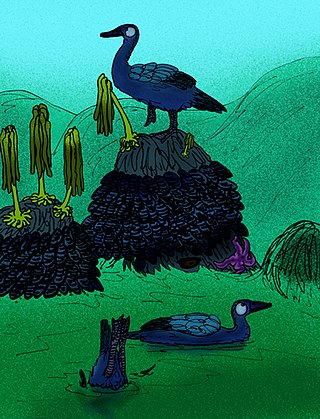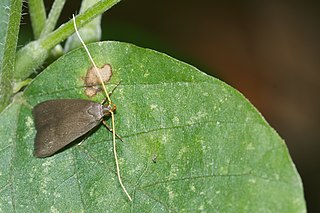
Chendytes lawi or Laws Duck is an extinct, goose-sized flightless marine duck, once common on the California coast, the California Channel Islands, and possibly southern Oregon. It lived in the Pleistocene and survived into the Holocene. It appears to have gone extinct at about 450–250 BCE. The youngest direct radiocarbon date from a Chendytes bone fragment dates to 770–400 BCE and was found in an archeological site in Ventura County. Its remains have been found in fossil deposits and in early coastal archeological sites. Archeological data from coastal California show a record of human exploitation of Chendytes lawi for at least 8,000 years. It was probably driven to extinction by hunting, animal predation, and loss of habitat. Chendytes bones have been identified in archaeological assemblages from 14 coastal sites, including two on San Miguel Island and 12 in mainland localities. Hundreds of Chendytes bones and egg shells found in Pleistocene deposits on San Miguel Island have been interpreted as evidence that some of these island fossil localities were nesting colonies, one of which Guthrie dated to about 12,000 14C years. There is nothing in the North American archaeological record indicating a span of exploitation for any megafaunal genus remotely as long as that of Chendytes.

The Mediterranean, Southern or Miller's water shrew is a species of insectivoran mammal in the family Soricidae.

The Carmen Mountain shrew is a species of mammal in the family Soricidae. It is endemic to Mexico.

Orson Knapp Miller Jr. was an American mycologist. He published numerous papers in mycology and was responsible for the naming of many taxa, as well as being one of the authors erecting the genus Chroogomphus. He described Omphalotus olivascens, several species of Amanita, and the ghoul fungus Hebeloma aminophilum.

Palaeocoma is an extinct genus of brittle stars that lived during the Middle Triassic to Early Jurassic Periods. Its fossils have been found in Europe.

The Lecithocerinae are a subfamily of small moths in the family Lecithoceridae. They are found worldwide, but most species occur in South Asia. The subfamily is characterized by the male genitalia with a bridge-like structure connecting the tegumen and the valva, and the uncus almost always is vestigial with two lobes at the dorsal base, only exceptionally united into a broad plate, but never as a thorn or spine.

Acheloma is an extinct genus of temnospondyl that lived during the Early Permian. The type species is A. cumminsi.

Chenoprosopus is a genus of extinct cochleosauridae that lived during late Carboniferous and early Permian periods. Two known species of Chenoprosopus are C. milleri and C. lewisi. Chenoprosopus lewisi was described in the basis of a virtually complete skull with maximum skull length of 95 mm. It is significantly smaller than Chenoprosopus milleri and was differentiated from that taxon by Hook (1993) based on sutural patterns of the skull roof. Hook also mentioned the reduced size of the vomerine tusks differentiated C. lewisi from C. milleri, but the different size of these tusks may be different ontogenetic stages of growth. Many of other cochleosaurids from the same time period have an elongated vomer and wide and elongate choana. However, Chenoprosopus is distinguished by its more narrowly pointed snout and separation between the nasal from the maxilla by the broad lacrimal-septomaxilla contact.

The Streptococcus anginosus group (SAG), also known as the anginosus group streptococci (AGS) or the milleri group streptococci (MGS), are a group of several species of streptococci with clinical similarities. The group is named after a principal member species, Streptococcus anginosus. The older name Streptococcus milleri is now pseudotaxonomic, as the idea that these streptococci constituted a single species was incorrect. The anginosus group streptococci are members of the viridans streptococci group. They have been implicated as etiologic agents in a variety of serious purulent infections, but because of their heterogeneous characteristics, these organisms may be unrecognized or misidentified by clinical laboratorians. The unique characteristic of them from other pathogenic streptococci, such as S. pyogenes and S. agalactiae, is their ability to cause abscesses.
Maxacteon milleri is a species of small sea snail, a predatory marine gastropod mollusc in the family Acteonidae, the barrel bubble snails.

Cynomops is a genus of Central and South American dog-faced bats in the family Molossidae. It has sometimes been considered a subgenus of Molossops. It contains the following species:

Abies milleri, an extinct species of fir known from fossil remains found in deposits from the early Eocene Ypresian stage in Washington State, USA, is the oldest confirmed record for the fir genus.

Miller's saki, also known as Miller's monk saki, is a species of saki monkey, a type of New World monkey. Its range includes parts of southwestern Colombia, northeastern Ecuador, and perhaps adjacent areas in Peru. This species was originally described as a species by J. A. Allen, demoted to a subspecies of the monk saki in 1987, and raised back to full species status in 2014. Confusion over the taxonomy of saki monkeys has arisen in part due to poorly labeled or mislabeled museum specimens. Males and females of this species, like those of other sakis, have differently colored pelage, with the females being more grayish in the face and overall, and the males a darker, grizzled black but with brown in the face and forearms.
Neotimyra is a genus of moths in the family Lecithoceridae.
Neotimyra gyriola is a moth in the family Lecithoceridae. It was described by Kyu-Tek Park in 2011. It is found on New Guinea.
Neotimyra nemoralis is a moth in the family Lecithoceridae. It was described by Kyu-Tek Park in 2011. It is found on New Guinea.
Neotimyra senara is a moth in the family Lecithoceridae. It was described by Kyu-Tek Park in 2011. It is found on New Guinea.
Neotimyra warkapiensis is a moth in the family Lecithoceridae. It was described by Kyu-Tek Park in 2011. It is found on New Guinea.

Cynomops milleri is a species of bat that is native to South America. It was previously considered a subspecies of the Para dog-faced bat. It is considered a small- to medium-sized member of its genus. It is classified as least concern by the International Union for Conservation of Nature because it appears to be common and widespread. It is found in Venezuela, French Guiana, Guyana, Suriname, Brazil, and Peru.
Schuchertinia milleri, commonly known as the Miller hydractinia, hedgehog hydroid or snail fur, is a small colonial hydroid in the family Hydractiniidae, found in the eastern Pacific Ocean. It forms mat-like colonies on rocks, or sometimes on the mollusc shells occupied by hermit crabs.












